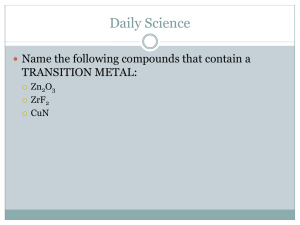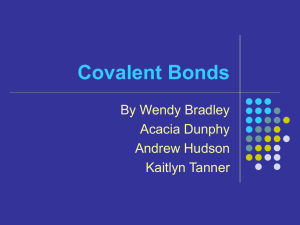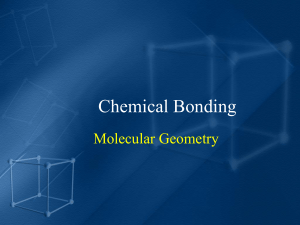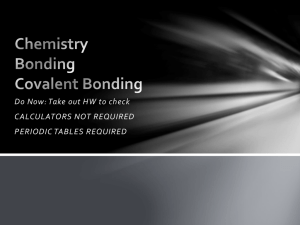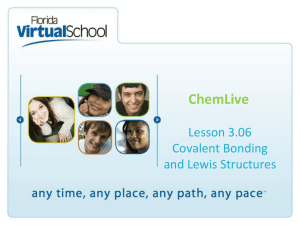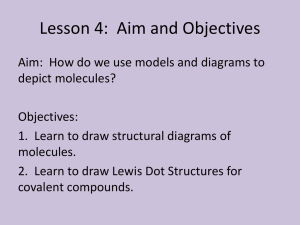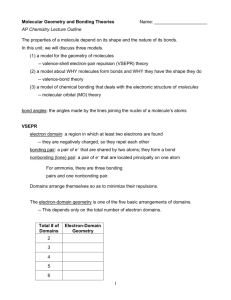Presentation1 11-3-2013
advertisement
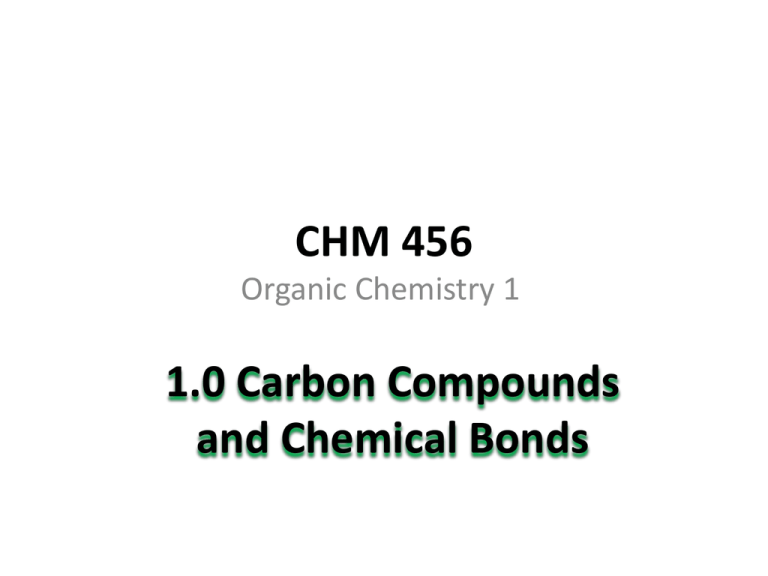
CHM 456 Organic Chemistry 1 1.0 Carbon Compounds and Chemical Bonds Objectives • • • • • • • • Understand what a bond is Why they form Lewis strictures (assigning e- in bonds) Hybridization (mixing of orbitals) Molecular shapes Types of bonds (covalent, ionic, dative) Formal Charge (calculatione) Resonance (spreading of charge) What is a bond? • A electrostatic attraction between electrons and the protons inside of two (or more) nuclei. • Hydrogen (the simplest case) - attracted to + http://www.middleschoolchemistry.com/multimedia/chapter4/lesson4 Why do bonds form? • Due ultimately to Entropy (symbol ‘S’) • Think of entropy as the disordered distribution of energy. • A process can only occur if it leads to a overall increase in entropy. Many bond forming reactions lead to an increase the entropy. Why do bonds form? • A chemical reaction increases the amount of entropy usually by giving off heat energy (enthalpy) (exothermic reaction), which then randomly disperses throughout the surroundings (i.e. the universe). • Sometimes reactions are endothermic, so increase in entropy by the products formed is greater than the heat (enthalpy) loss of the surroundings (Heat energy, exothermic) and Entropy (Energy of ‘disorder’) increases MORSE CURVE Repulsive Energy 0 Attraction Energy http://www.webchem.net/notes/chemical_bonding/covalent_bonding.htm How quickly do bonds form • The speed (rate) at which a reaction occurs depends on a few factors, perhaps the most important is the reactions ACTIVATION ENERGY • The minimum amount of energy necessary for a chemical reaction to occur. It acts as a ‘barrier’, preventing reaction. http://www.chem.msu.su/eng/teaching/Kineticsonline/chapter6e_ad.html Reaction rate, Activation Energy. • A HIGHER the activation energy (symbol Ea) , more of a barrier, the slower the rate of reaction. • The LOWER the activation energy, less of a barrier, the quicker the reaction will occur. Ea ↑, then rate ↓ Types of bonds 1) Formation of covalent bonds: A pair of e- is shared between two atoms. Each atom contributing one electron. – A subcategory of this is dative covalent bonds or coordinate bonds. A pair of e- is shared between two atoms, both e- come from just one atom The bond is due to the mutual(joint) attraction for the shared e- pair between the nuclei s responsible for the 2) Ionic bonds. Electrons are transferred from one atom to another. Types of bonds 2) Formation of Ionic bonds. Electrons are transferred from one atom to another. The bond is due to the electrostatic attraction between the resulting positive and negative ions. Dual character • In reality many substances show a degree of each type of bonding. E.g. CaI2 is ionic with partially covalent character. • AlBr3 is covalent with partially ionic character This is due to polarisation http://www.ibchem.com/IB/ibnotes/full/bon_htm/4.2.htm Dot cross diagrams http://2a2science.blogspot.com/2011_02_10_archive.html http://www.ibchem.com/IB/ibnotes/full/bon_htm/4.2.htm • VERY IMPORTANT • Applies to covalent bonds • Causes the polarisation of covalent bonds http://www.pta210.info/Handouts/Electronegativity%20Table.gif Molecular SHAPE (VSEPR) • VSEPR in Chemistry (Low).flv (relative link) • VSEPR Theory (Low).flv (video 2) http://www.masterorganicchemistry.com/2010/09/24/how-to-calculate-formal-charge/ Intermolecular forces NEED TO KNOW ABOUT ELECTRONEGATIVITY AND MOLECULAR SHAPE • These are attractions between (or ‘in between’) DIFFERENT independent species, e.g. water molecules, or Br2 molecules or CO2 molecules. • The are NOT the same as the BONDS that are responsible for the formation of molecules ( or ion pairs). Intermolecular foeces. Van der Waals forces 1/3 Hydrogen bond. A H atom is bonded to an N, O or F atom and interacts with a lone pair of electrons on a different N, O or F Found in: Water, HF, ammonia, alcohols, carboxylic acids, amines, water with propanone, water with ethanal Water molecules http://alevelnotes.com/?id=135 2/3 Dipole-dipole forces. A polarised part of a molecule attracted to a different and oppositely charged polarised part of a molecule. Need to know about ELECTRONEGATIVITY ! and molecular shape Adapted from http://flatworldknowledge.lardbucket.org/boo ks/introductory-chemistry/section_14_01.html 3/3 Induced dipole-induced dipole forces (London dispesion forces, or temporary dipole – temporary dipole) Electrons clouds distort randomly and at one instant become polarised which can cause polarisation in adjacent molecules. http://www.dlt.ncssm.edu/tiger/chem3.htm IMF videos - Watch these videos! Summary Videos = http://www.youtube.com/watch?v=dQ33T VQCfyY RELATIVE LINK Note specific animation of induced-induced dipoles = from 4m:39s onwards • http://www.youtube.com/watch?v=S8QsLUO_ tgQ&NR=1&feature=endscreen Dr Paul McCord RELATIVE LINK • Nice (but brief) website on molecular geometry: http://www.elmhurst.edu/~chm/vchembook/20 8introgeom.html spdf notation spdf notation http://titanchem1.blogspot.com/ Hybridization Sigma (s) bonding sigma bonds have a plane of symmetry along an internuclear axis. http://89.97.218.226/web1/letiochem/lezioni/sigma-pigreco.htm pi (π) bonding Nodal pane http://89.97.218.226/web1/letiochem/lezioni/sigma-pigreco.htm Double bonds WEAKER ATTRACTION (=weaker bond =more reactive bond) of e- in pi-bond to the nucleus as e- are further away!!! http://chempaths.chemeddl.org/services/chempaths/?q=book/General%20Chemistry%20Textbook/Further%20Aspects%20of%20Covalent%20Bondi ng/1345/sigma-and-pi-bonds C≡C (triple bond) http://chemistrypractice.blogspot.com/2010/10/multiple-bond.html Other representations… http://www.brynmawr.edu/chemistry/ Chem/Chem103Lkdl/consider/consider5.htm http://www.wag.caltech.edu/home/jsu/Thesis/node46.html Other representations… http://www.chem.ufl.edu/~itl/4412_aa/ccbon d.html http://www.chem.ufl.edu/~itl/2045/lectures/l ec_15.html Hybridization Hybridization http://iverson.cm.utexas.edu/courses/310M/Handouts/Handoutsfl05/MOVBTheory.html Hybridization • http://www.youtube.com/watch?v=g1fGXDRx S6k VIDEO: Hybridization (Low).flv (US) • http://www.youtube.com/watch?v=RsxDXnOgnk VIDEO: Hybridisation Hybridization (sp, sp2, sp3) (Low).flv (compilation) Antibonding • When you atomic orbitals coming together (in a chemical reaction) to form molecular orbitals, you produce bonding molecular orbitals AND anti-bonding molecular orbitals. • Read:http://www.chem.ufl.edu/~itl/2045/lect ures/lec_15.html for a good discussion of this. • and also Bonding and Anti-bonding http://www.chem.ufl.edu/~itl/2045/lectures/l ec_15.html ATOMIC ORBITALS MOLECULAR ORBITALS Formal Charge • Describes the localised charge (on atoms) in a molecule. It’s a useful tool*. • For an atom. Consider it’s electron environment. Then calculate the formal charge Formal charge = [# of valence electrons] – [electrons in lone pairs + 1/2 the number of bonding electrons] VIDEO: Formal Charges (Low).flv Formal Charge Alternatively (slight ‘simplification’ of the formula)… • Formal Charge = [# of valence electrons on atom] – [non-bonded electrons + number of bonds]. Resonance • A HUMAN IDEA / TOOL / METHOD to describe/show/predict the delocalisation of change. • Delocalisation = spreading out of electrons! • Delocalisation occurs to lower a molecules (or molecular ions) energy, chiefly by distributing negative charge to positive areas and lowering repulsion. http://chemwiki.ucdavis.edu/Theoretical_Chemistry/Chemical_Bonding/Resonance Resonance http://chemwiki.ucdavis.edu/Theoretical_Chemistry/ Chemical_Bonding/Resonance << GOOD SITE! Resonance contd. Resonance video: Drawing Lewis Structures Resonance Structures - Chemistry Tutorial http://www.youtube.com/watch?v=MWDL5WCZBzE (Low).flv (RELATIVE LINK) • Resonance and Predicting Chemical Reactivity (http://www.youtube.com/watch?v=oOBNJCNnFE8 ) Higher Level. 29mins

